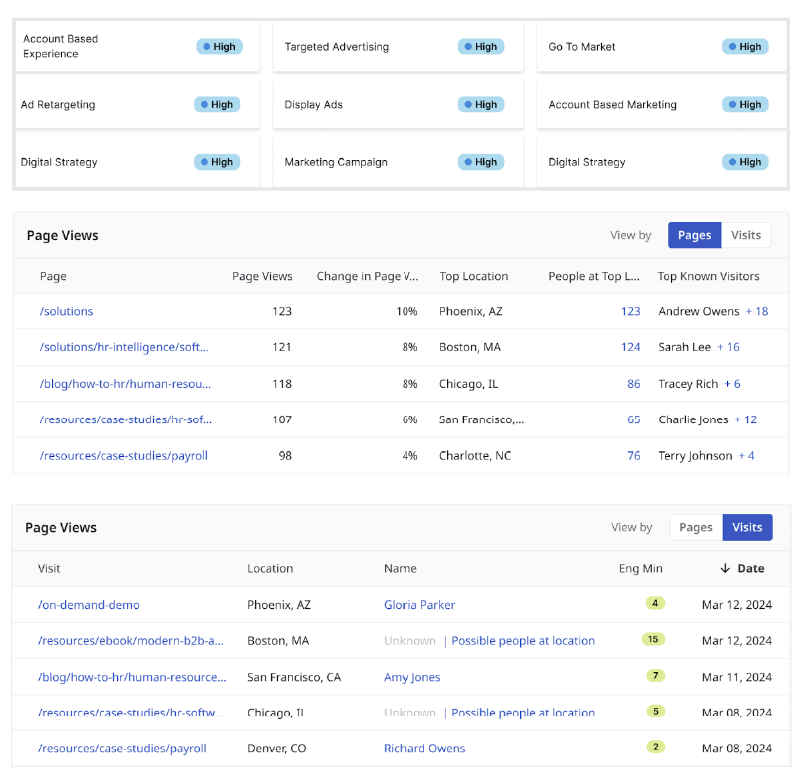Intent Data (On Its Own) Is Just Wishful Thinking
Explore the real worth of intent data for sales success

Jay Tuel
Vice President, GTM Experts, Demandbase
“Companies are lying about intent data.” — Vin Matano, Senior Account Executive, Majors at Demandbase + 🏆 President’s Club FY23.
Vin, who has spent the last 6+ years talking about intent on sales calls, admits he is no expert but has “closed millions of dollars of intent data.”
In that LinkedIn post, Vin says companies promise “hot leads” and “accounts ready to buy.” All good; however, intent data by itself is not enough.
A single search on a term does not mean an account is ready to buy (or even more likely to buy). They may not even know who you are!
Tom Keefe, Principal GTM Expert at Demandbase, also recently posted about intent, complete with a baking/sugar analogy.
“Do you go into your kitchen, grab a raw ingredient like sugar, and just eat it? Probably not, because 1) it tastes better when you mix it with something else and 2) you need more than just a single raw ingredient to no longer be hungry.”
And it’s not just Demandbase folks discussing intent. There’s also been a fair amount of chatter about intent data not being useful for sales.
Guess what side I’m on?
However, with the same caveat Vin and Tom shared, intent alone is not terribly useful for sales.
Intent data, or “buying intent” in marketing-speak, is just one piece of the puzzle. Or, if you are Tom, one ingredient in a more complete recipe.
Let me repeat: Intent data alone will not be the miracle pipeline and revenue driver we all hope for, but that doesn’t mean it isn’t critical in selling.
The (brief) history of intent data
First, a definition.
Intent data is the information (or “signals”) that indicate a prospect is researching a particular product or service — or, perhaps, showing intent to purchase. Companies use intent data to better understand where potential customers are in the buying journey, allowing for more targeted and effective marketing strategies.
The early days of intent data used in sales and marketing efforts began to pick up steam as web analytics tools became more sophisticated — when businesses started to track more nuanced user behaviors, such as click paths, time spent on pages, and interactions with specific content.
Fast forward to the early days of CRMs and marketing automation platforms, and businesses began to aggregate and analyze customer interactions across various channels, providing a more integrated view of customer intent.
Big data and machine learning significantly enhanced the capacity to process and analyze vast amounts of diverse data points. Businesses could now harness more complex datasets, including third-party data, to predict intent more accurately, and personalize marketing and sales strategies at scale.
Account-Based Marketing (ABM) platforms and real-time intent data empowered teams to micro-focus intent signals, engaging potential customers at critical moments in their decision-making process.
Which brings us to today.
Intent (by itself) is BS.
While the intentions of intent (!) were good — a measure of content consumption around specific relevant topics — some vendors now cast as wide a net as possible, degrading buying intent into potentially interested.
Many companies quickly jumped on the intent bandwagon and began offering “buyer intent” data, which inevitably showed a significant portion of your ICP being “in-market.” These vendors started promoting broad topics of keywords that were so generic and ubiquitous that they acted as a catch-all, delivering significant portions of sellers’ ICPs as “researching” accounts.
At the same time, these umbrella keywords began appearing on all sorts of websites — many unscrupulous — chock full of buzzword clickbait.
It’s no wonder sales called BS on intent!
This is 100% the type of intent data that should cause the hair on your arms to rise. Be skeptical. Trust your instincts. This approach to intent is disingenuous. It’s wrong. More importantly, using intent data alone means your team wastes time on leads less likely to close.
Will intent on its own point you in the right direction? Sure.
Is intent data an excellent place to start? Of course.
Should intent data be part of the picture? 100%.
Just as long as intent is not your only signal.
Intent + [a whole bunch of other things] is the answer
The ability to get specific about which keywords your prospects are researching, coupled with the ability to see the sources of that intent, is critical to making intent signals more relevant to sales.
The actual value to sellers comes from combining that intent with the real interest you see from first-party data — website visits, content engagement, attendance at in-person (or virtual) events, clicks on ads, etc.
Blend that information with known people in the account who are researching topics that not only relate to those intent signals but are also high-value pages that people doing active evaluations are likely to visit.
These actions together start to indicate the types of research that would be done before considering a buying cycle with a vendor.
Calli Taylor, Manager of Account Development at Domo, and her team of power users of intent insights relates sales to fishing:
Sales is like fishing. We must pick the stream or lake we will fish in (accounts). But that’s not enough. What fish are we going to go after in those accounts (personas, levels, above/below line)? Choosing the bait is equally important (intent insights for relevant messaging). Use intent for relevance to cast your message and get some bites!
Allowing sellers to choose the right bait is something Demandbase is quite good at.
How Demandbase thinks about intent
Let’s go back to Tom and his “raw ingredient” analogy.
Tom said, “If eating requires more than just a raw ingredient, why are you running your GTM plays based off a single raw ingredient like intent?
“GTM motions are complex, just like our appetites; we need more than a single signal to ‘feed’ the GTM Engine.
“Intent is like sugar, an amazing single ingredient, but it doesn’t do a whole lot for you if you consume it individually.”
A Demandbase example:

We see an account showing intent on digital advertising AND competitive ad tech. We dig in more and uncover several known people on our site, half of whom are digital marketing personas visiting advertising solution pages and looking up two case studies of customers using our advertising product.

That is real intent — no matter how you define it. This is what sales people want to see.
Intent will not magically give you the silver bullet that makes all prospects respond automatically. Outbound is difficult, but Demandbase makes it easier by providing a variety of signals and relevant tools for your outreach and ongoing conversations.
Let me be clear: Prospects no longer want relevance; they expect it. They demand it.
Our job as sellers and marketers is to show up with our A-game at every touchpoint in prospecting, throughout the sales cycle, and across the entire customer journey.
Leveraging intent together with first-party data is the key.
The frustration with intent is understandable. But instead of objecting to it, let’s start a dialogue about how to utilize it better — education and sharing of best practices to make intent work more effectively. That’s our mission.
Here is a checklist I created to help work through all areas of intent. It’s time to find your next opportunity!
As the VP of GTM Experts, I want to help sellers do this more effectively to create more pipeline, drive more revenue, and end up on the beach at President’s Club.
Join me. Let’s go.

Jay Tuel
Vice President, GTM Experts, Demandbase



